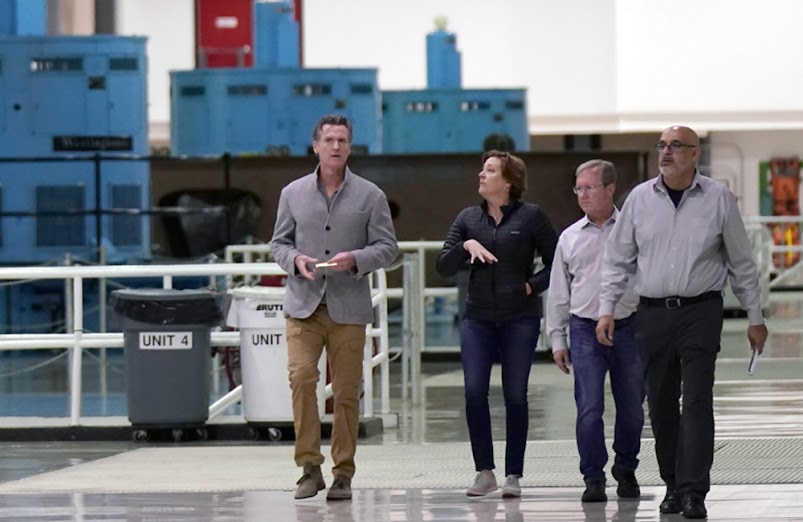 |
| While working at a fire on San Bruno Mountain near Brisbane, Calif., a helicopter drops water near power lines and electrical towers. On Friday, May 6, 2022, California energy authorities predicted that the state would face an energy shortage this summer. Drought, high heat, and wildfires are just a few of the issues that will make energy reliability difficult this summer and in the future years. Image Credit: AP Photo/Jeff Chiu, File |
According to experts, energy reliability will be problematic this summer due to drought, extreme heat, and wildfires, as well as supply chain and regulatory difficulties afflicting the solar business. They represented the California Public Utilities Commission, the California Energy Commission, and the California Independent System Operator, as well as the state's energy grid administrators.
In the hottest months, when air conditioners are in full usage, official models anticipate the state will have 1,700 megawatts less power than it needs during peak demand—typically early evening as the sunsets.
According to the California Energy Commission, one megawatt may power between 750 and 1,000 homes. The gap may be even larger in the worst-case scenario: 5,000 megawatts, or enough to power 3.75 million homes.
"The only thing we expect is to see new and surprising conditions," said Alice Reynolds, president of the California Public Utilities Commission, which supervises large utilities like Pacific Gas & Electric.
 |
| Electrical power flow and conditions are monitored at the California Independent System Operator grid control center in Folsom, California, Aug 18, 2017, file photo. On Friday, May 6, 2022, California energy authorities predicted that the state would face an energy shortage this summer. Californians should prepare to limit their energy use after work hours, according to officials from the ISO, the California Energy Commission, and the California Public Utilities Commission. Image Credit: AP Photo/Rich Pedroncelli, File. |
According to the independent system operator, large hydropower projects generated roughly 14% of the state's electricity in 2020. Renewable energy, primarily solar, accounted for 34.5 %, while nuclear power provided for 10%.
In the face of expected shortfalls this summer, the state—and residents—have a number of options for avoiding blackouts. Officials warned that while power can be acquired from other states and residents can reduce their use during peak demand, power shortages are still conceivable in extreme cases. Reynolds asked residents to think about ways to save energy, such as cooling their houses early in the day and turning off their air conditioners when the sunsets.
In August 2020, the California Independent System Operator ordered companies to cut power to hundreds of thousands of consumers due to excessive heat.
If the entire West has a heatwave at the same time, Mark Rothleder, senior vice president of the system operator, believes the state will be more likely to face blackouts this year. California's capacity to buy extra power from other states would be hampered as a result. Wildfires might also make it difficult for the state to keep the lights on, he warned.
California is shifting its grid away from carbon-emitting electricity sources and toward carbon-free alternatives such as solar and wind power. The state has fewer energy options as outdated power reactors, like the Diablo Canyon Nuclear Power Plant, prepare to retire. Due to planned power plant shutdowns, the state will lose 6,000 megawatts of power by 2025.
 |
| Gov. Gavin Newsom left, and Department of Water Resources Director Karla Nemeth, second left, tour the Edward Hyatt Power Plant at the Oroville Dam in Oroville, Calif., Tuesday, April 19, 2022. California energy authorities predicted that the state would face an energy shortage this summer on Friday, May 6, 2022. Newsom took a tour of the hydropower plant and spoke about how the drought is affecting power generation. Image Credit: AP Photo/Rich Pedroncelli, File |
Meanwhile, pandemic-related supply chain concerns are delaying the availability of equipment needed to set up more solar power systems with batteries to store energy for usage when the sun isn't shining.
The state officials also mentioned a US Department of Commerce inquiry into solar panel imports from Southeast Asia as something that could stymie California's efforts to become green.
California has set a goal of obtaining 100% of its electricity from non-carbon sources by 2045, with milestones such as 60 percent by 2030. The state already exceeds that goal on occasion, especially throughout the day. The amount of energy generated by renewable sources varies depending on the time of day, year, and what is available.
Around 3 p.m., the system operator claimed to have set a new record of getting more than 99 percent of its energy from non-carbon sources, albeit this only lasted a few minutes.
 |
| This Nov. 3, 2008, file photo shows one of Pacific Gas and Electric's Diablo Canyon Power Plant's nuclear reactors in Avila Beach, Calif. California energy leaders said Friday, May 6, 2022, that the state may see an energy shortfall this summer. Facing possible electricity shortages, Gov. Gavin Newsom raised the possibility that the state's sole remaining nuclear power plant might continue operating beyond a planned closing by 2025.Image Credit: AP Photo/Michael A. Mariant, File |
Since the 2020 power disruptions, Pacific Gas & Electric, which serves approximately 16 million people in California, has added more battery storage and is working on measures to minimize the energy load during peak demand, according to spokeswoman Lynsey Paolo. She said the company is saving water in hydroelectric reservoirs and informing consumers about ways to cut demand. Diablo Canyon, which the utility manages, was not mentioned in her statement.
Another major utility, Southern California Edison, is working to secure extra electricity, complete its own battery storage project, and encourage customers to consume less energy, according to spokesman David Song.
"During the summer months, when customers rely on electric service for air conditioners and fans during extended heat waves," he said, "Southern California Edison realizes how much our customers depend on reliable electricity that is supplied safely."









0 Comments
please do not enter any spam link in the comment box